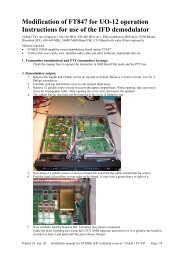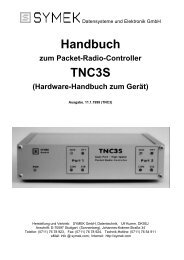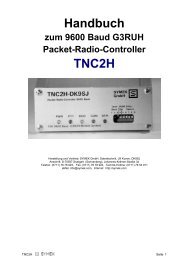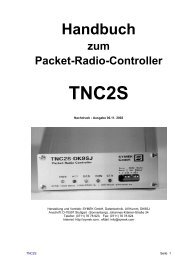Sie wollen auch ein ePaper? Erhöhen Sie die Reichweite Ihrer Titel.
YUMPU macht aus Druck-PDFs automatisch weboptimierte ePaper, die Google liebt.
AX.25 Version 2 Multi-channel TNC FIRMWARE(version 2.6) copyright 1990, Ronald E. Raikes (WA8DED)This firmware supports the full AX.25 link-layer protocol, version 2.0 as described in the ARRL specificationdated October 1984, as well as the pre-existing version 1.x. This implementation supports multiplesimultaneous link connections with either version protocol. This release has been compiled for a maximum offour connections, although any reasonable number of connections is possible by changing one MAXLNKsymbol in the source header file. The firmware is contained in one 26256 EPROM, and is intended to beinstalled in a TAPR TNC-2 (or equivalent, such as the MFJ-1270 or AEA PK-80) in socket U23. RAM memory isautomatically sized, supporting both 16k and 32k configurations.Commands and information are sent to the TNC in the form of lines. Lines may be up to 256 characters long,including the terminating CARRIAGE RETURN. If the 256th character entered is not a CARRIAGE RETURN, itwill be discarded and a BELL character will be output to the terminal. BACKSPACE and DELETE may be usedto remove single characters from the line. The entire line may be permanently backspaced out by entering aCONTROL-U or CONTROL- X. A CONTROL-R will temporarily backspace out any partial line to allow incomingframes to be displayed. A second CONTROL-R will then restore the line to allow continuation of entry. Duringthe time a partial line is saved, only another CONTROL-R will be accepted from the keyboard (with theexception of xon/xoff, of course). BELL characters are echoed to the terminal when entered or removed. Lineswhich begin with an ESCAPE character (echoed as '* ') are interpreted as commands. If a command is issuedwith no parameter, the current value of that commands parameter is displayed. Lines without a leadingESCAPE character are sent as information.The firmware provides the operator with five virtual TNC channels, numbered 0 to 4. The terminal is logicallyattached to only one of these channels at a time, selected by the 'S' command. Information sent on channel 0 isalways unproto. The unproto path may be set by issuing a 'C' command when channel 0 is selected. Channels1 - 4 are also unproto if they are not currently connected. Outgoing connect requests may be issued on anyunconnected channel, while incoming connect requests will use the first available channel (provided themaximum number of connections set by the 'Y' command will not be exceeded).Information received on a connected channel that is not currently selected will remain queued there until thatchannel is selected. The STA led indicates there is queued information, and the 'L' command may be used todetermine the channel(s) where it is located. Information for transmission is sent only to the currently selectedchannel. When a connection is ended, received information will remain queued until it has been displayed. If anew digipeater path is desired while a connection is being established or is in progress, it is not necessary todisconnect first. Simply re-issuing the 'C' command will re-establish the connection via the new path without anyloss of information.Which protocol version is used to initiate a connection is controlled by the 'V' command, but the version will bechanged automatically, if necessary, to conform to the version of the TNC responding. Version 2 protocol ismore effecient in terms of network throughput and loading, especially under severe conditions. Version 2protocol is the default and should be used whenever possible. When version 2 protocol is used, a watch-dogtimer is started whenever information is not being transmitted. If the TNC remains idle for three minutes, it willpoll the other TNC to determine if the link is still established. If no response is received after the number of triesset by the 'N' command, a link failure is reported. This procedure will also detect the case where someoneconnects and then leaves without disconnecting. Changing the protocol version during a connection is notpermitted.The 'F', 'I', 'N', 'O', and 'V' commands maintain individual parameters for each channel. The value stored inchannel 0 is used to initialize channels 1 - 4 upon power up, and to re-initialize channels 1 - 4 after adisconnect. This allows the values to be changed independently on each channel, prior to and during aconnection, and then automatically revert back to the standard values when the connection is ended. A 'D'command issued on a disconnected channel 1 - 4 will also re-initialize that channel.Frame monitoring is controlled by the 'M' command. The command parameter determines the types of framesmonitored, and is a list of desired frames chosen from the letters in the following table:N NoneI I framesU UI framesS Supervisory framesC Monitor while connected+ Call signs to be included (maximum of 8)- Call signs to be excluded (maximum of 8)09.11.02 erweitertes <strong>Handbuch</strong> zum TNC Seite 43








